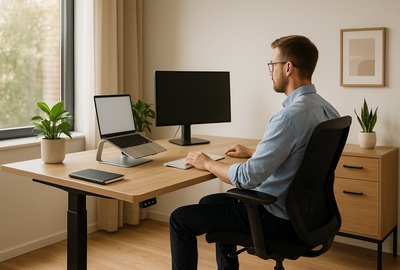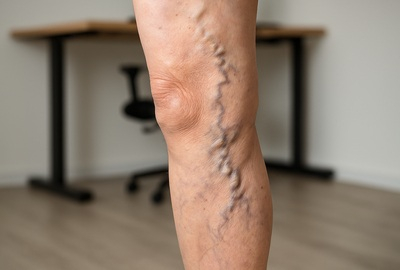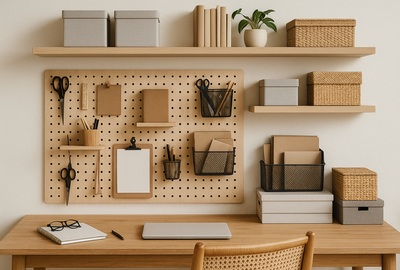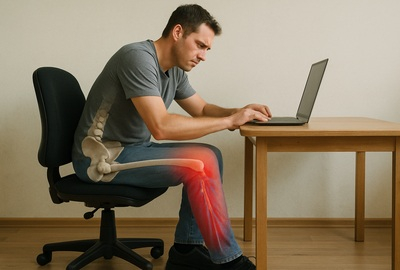- Office Ergonomics Checklist: Improve Comfort & Efficiency
- 1. How to Use an Office Ergonomics Checklist to Stay Comfortable and Productive
- 2. The Complete Workstation Ergonomics Checklist for Any Computer Workstation
- 3. Must-Have Tools to Maintain a Neutral Position in a Standing Position
- 4. Ergonomic Mistakes to Avoid When Working in a Seated or Standing Position
- 5. How an Ergonomic Checklist for Office Settings Boosts Long-Term Efficiency
- 6. Building a Custom Ergonomic Setup for Different Workers and Tasks
- 7. Why a Neutral Position and Routine Adjustments Help Maintain Posture
- 8. Start Your Ergonomic Assessment Using a Practical Office Ergonomics Checklist
Office Ergonomics Checklist: Improve Comfort & Efficiency
Most people don’t notice bad posture until their neck or shoulders start complaining. But with a solid office ergonomics checklist, it’s easy to fix the small stuff—like poor font size, the wrong screen distance, or a dangling cable that's a trip hazard.
Whether your work activities include writing reports or fielding video calls near windows, posture matters. The aim is simple: keep your shoulders relaxed, your tools within reach, and make tiny changes that reduce strain. Here's a guide to help you carry better habits into every workday.
1. How to Use an Office Ergonomics Checklist to Stay Comfortable and Productive
If you're working long hours at a desk, using an office ergonomics checklist isn't optional—it’s essential. It helps reduce discomfort, prevent injury, and improve focus. Most workers only realize the impact of poor posture after they develop tension in the neck, lower back, or shoulders.
Start by examining your position. Is your monitor at eye level? Are your feet flat on the floor, shoulders relaxed, and arms close to the body? Your chair should provide lumbar support, and your keyboard and mouse should be at arm's length, letting your upper arms hang naturally by your body.
This applies whether you sit all day or alternate between sitting and standing. The goal is to make your computer work easier on your body and aligned with long-term health and safety principles.
2. The Complete Workstation Ergonomics Checklist for Any Computer Workstation
An effective workstation ergonomics checklist should review your entire computer workstation. That means your desk, chair, monitor, input devices, and even your foot placement.
- Monitor at eye level with no tilt strain
- Keyboard at a height that keeps arms in a neutral position
- Mouse close to the keyboard, avoiding reach
- Chair must be fully adjustable with proper back rest and support
- Feet should stay flat, with knees at a right angle
- Use a non-reflective surface to reduce glare and improve visual comfort
These ergonomic basics enable a healthier workflow and better overall safety during long computer work sessions.
3. Must-Have Tools to Maintain a Neutral Position in a Standing Position
Shifting to a standing position can boost circulation—but only if you're still supporting your body correctly.
- Standing desk that’s fully adjustable
- Monitor risers for proper screen position
- Anti-fatigue mats for foot relief
- Ergonomic keyboard and mouse setups
- Lighting for better visual comfort
All tools should promote a neutral position and reduce static position strain during long periods of work.
4. Ergonomic Mistakes to Avoid When Working in a Seated or Standing Position
- Forgetting adequate breaks
- Working in a static position without movement
- Poor mouse and keyboard layout causing arm strain
- Skipping adjustments when switching tasks
- Ignoring support under your surface, causing improper angles
One frequent example: a person leaning forward due to an angled monitor or sloped desk—a small issue that leads to major posture problems over time.
5. How an Ergonomic Checklist for Office Settings Boosts Long-Term Efficiency
A smart ergonomic checklist for office setups protects your health and productivity. The real value? Fewer aches, better focus, and more consistent work output.
- Avoid manual tasks that require overreaching
- Reduce risk of repetitive strain injuries
- Work safely with good alignment and gear
- Enable smoother, faster transitions between work activities
It's not just about feeling better—it’s about performing better too.
6. Building a Custom Ergonomic Setup for Different Workers and Tasks
Every team is made of different workers, so customizing their workstation is essential. No two people have the same height, role, or workload.
- Ensure gear is fully adjustable
- Position monitors, keyboard, and mouse for comfort
- Adjust support for lower back, neck, and legs
- Account for variations in surface height and available space
These tweaks help everyone from admins to analysts carry out their work activities without strain.
7. Why a Neutral Position and Routine Adjustments Help Maintain Posture
Even a great setup needs maintenance. To prevent fatigue and muscle stress, always check if you’re still in a neutral position. Your head, arms, and shoulders should feel aligned—not tense.
- Build in movement breaks
- Adjust your chair, monitor, or keyboard weekly
- Watch for subtle shifts in position and correct them
- Replace any gear that stops offering proper support
Over time, these micro-adjustments help you maintain strong, efficient posture.
8. Start Your Ergonomic Assessment Using a Practical Office Ergonomics Checklist
Print this page, review your setup, and start checking. A regular ergonomic assessment paired with this office ergonomics checklist gives you control over comfort and performance.
Even slightly repositioning your monitor, clearing space under your desk, or modifying font size on your screen can reduce daily stress.
If you're not sure where to start, Deskup’s range of ergonomic furniture and tools can help you build the right setup today.
Comfort isn’t about big changes. It’s about making small, smart tweaks—like adjusting space for your arms, or slightly raising your monitor.
Print this page, review it weekly, and adjust as you go. Over time, you’ll move better, remain focused, and work more naturally. If you're not sure where to begin, Deskup’s ergonomic tools make it easier to stay aligned and supported.


 Buy Now, Pay Later
Buy Now, Pay Later Verified Rating
Verified Rating 






